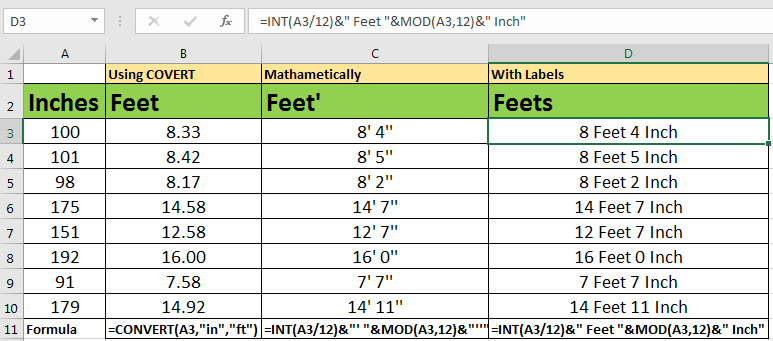How to Write Inches – Have you ever wondered how to write inches and centimeters? Have you ever wanted to find out the measurement of inches and feet? Well then, this post is for you. Let’s take a look at how to write inches and centimeters as well as learn the process on how to write 2 inches.
Table of Contents
No period after abbreviations, except one
Only “in” for inch takes a period afterward, in order to differentiate it from the preposition “in.” Others don’t.
Incorrect
1 cm.
1 in
1 lb.
Correct
1 cm
1 in.
1 lb
Non-breaking space in between a number and the measurement unit
Why? If your number ends up at the end of a line, the measurement will not appear all alone in the beginning of the next line. It makes sense to keep a number and its unit together, at all times. Thus, the non-breaking space.
Leave one space between a number and its unit and do not italicize the unit abbreviation.
Incorrect
1cm
1 mm
1lb
Correct
1 cm
1 mm
1 lb
A bit (b or bit) versus a byte (B)
A bit is the abbreviation of “binary digit” and its value is either one (1) or zero (0).
A byte, on the other hand, means “a collection of bits” and is used to code alphanumeric characters. That’s why it does not make sense to talk about “bit size” (it’s always 1 digit) but makes perfect sense to refer to “byte size” (since the number of bits in a byte differs from one application to another). If in doubt, you can safely assume that 1 Byte is 8 bits.
Recommended practice: write out bits openly as in “123 kbits” to differentiate it from “bytes.”
Recommended
1 B (byte)
1 bit (bit)
1 MB (megabyte)
1 Mbits
Physical Dimensions and Screen Resolution
Write the physical dimensions of a page or an object by using the word “by” and not multiplication sign or the letter “x”.
Use the multiplication sign “x” (× in HTML) (but not the letter “x”) for expressing screen resolution.
Incorrect
8.5×11 inches
1280 by 1024
Correct
8.5″-by-11″ or 8.5-by-11-inches
1280 x 1024
Different notation for dates
God knows how many mistakes have been committed in the past due to the differences in American and non-American way of writing the dates. 5/11/2010 is May 11, 2010 in the USA but November 5, 2010 in many other countries around the world. That’s why I have to classify the American way of writing dates as “incorrect” since it can lead to errors, depending on the cultural background of the reader.
Incorrect
5/11/2010
12/1/2010
Correct
May 11, 2010
December 1, 2010
Singular and plural for units
If the measurement is less than one use singular unit — except for zero :-). For units of measure larger than one use plural units.
Incorrect
0 inch
0.7 inches
10 inch
Correct
0 inches
0.7 inch
10 inches
No comma for addresses, decimal fractions, and page numbers
Incorrect
page 3,358
67,890 Main Street
0.85,674
Correct
page 3358
67890 Main Street
0.85674
The inch is a commonly used customary unit of length in the United States, Canada, and the United Kingdom. It is also used in Japan for electronic parts, especially display screens. In most of continental Europe, the inch is also used informally as a measure for display screens. For the United Kingdom, guidance on public sector use states that, since 1 October 1995, without time limit, the inch (along with the foot) is to be used as a primary unit for road signs and related measurements of distance (with the possible exception of clearance heights and widths)[9] and may continue to be used as a secondary or supplementary indication following a metric measurement for other purposes.
Inches are commonly used to specify the diameter of vehicle wheel rims, and the corresponding inner diameter of tyres – the last number in a Car/Truck tire size such as 235/75 R16; the first two numbers give the width (normally expressed in millimetres for cars and light trucks) and aspect ratio of the tyre (height 75% of width in this example), the R Designates a Radial Ply Construction. Wheel manufacturers commonly specify the wheel width in inches (typically 6.5, 7, 7.5, or 8 for 235/75 tire).[citation needed]
The international standard symbol for inch is in (see ISO 31-1, Annex A) but traditionally the inch is denoted by a double prime, which is often approximated by double quotes, and the foot by a prime, which is often approximated by an apostrophe. For example; three feet, two inches can be written as 3′ 2″. (This is akin to how the first and second “cuts” of the hour are likewise indicated by prime and double prime symbols, and also the first and second cuts of the degree.)
Subdivisions of an inch are typically written using dyadic fractions with odd number numerators; for example, two and three-eighths of an inch would be written as 2+3/8″ and not as 2.375″ nor as 2+6/16″. However, for engineering purposes fractions are commonly given to three or four places of decimals and have been for many years.Measuring tape calibrated in 32nds of an inch
Equivalents[edit]
1 international inch is equal to:
- 10,000 tenths[a]
- 1,000 thou[b] or mil[c]
- 100 points[d] or gries[e]
- 72 PostScript points[f]
- 10,[g][e] 12,[h] or 40[i] lines
- 6 computer picas[j]
- 3 barleycorns[k]
- 25.4 millimetres exactly (1 millimetre ≈ 0.03937008 inches)
- 0.999998 US Survey inches
- 1/3 or 0.333 palms
- 1/4 or 0.25 hands[l]
- 1/12 or 0.08333 feet
- 1/36 or 0.02777 yards
Conclusion
Thank you for reading, i hope this article would have given you a better insight on how to write inches and other measurement properly.
